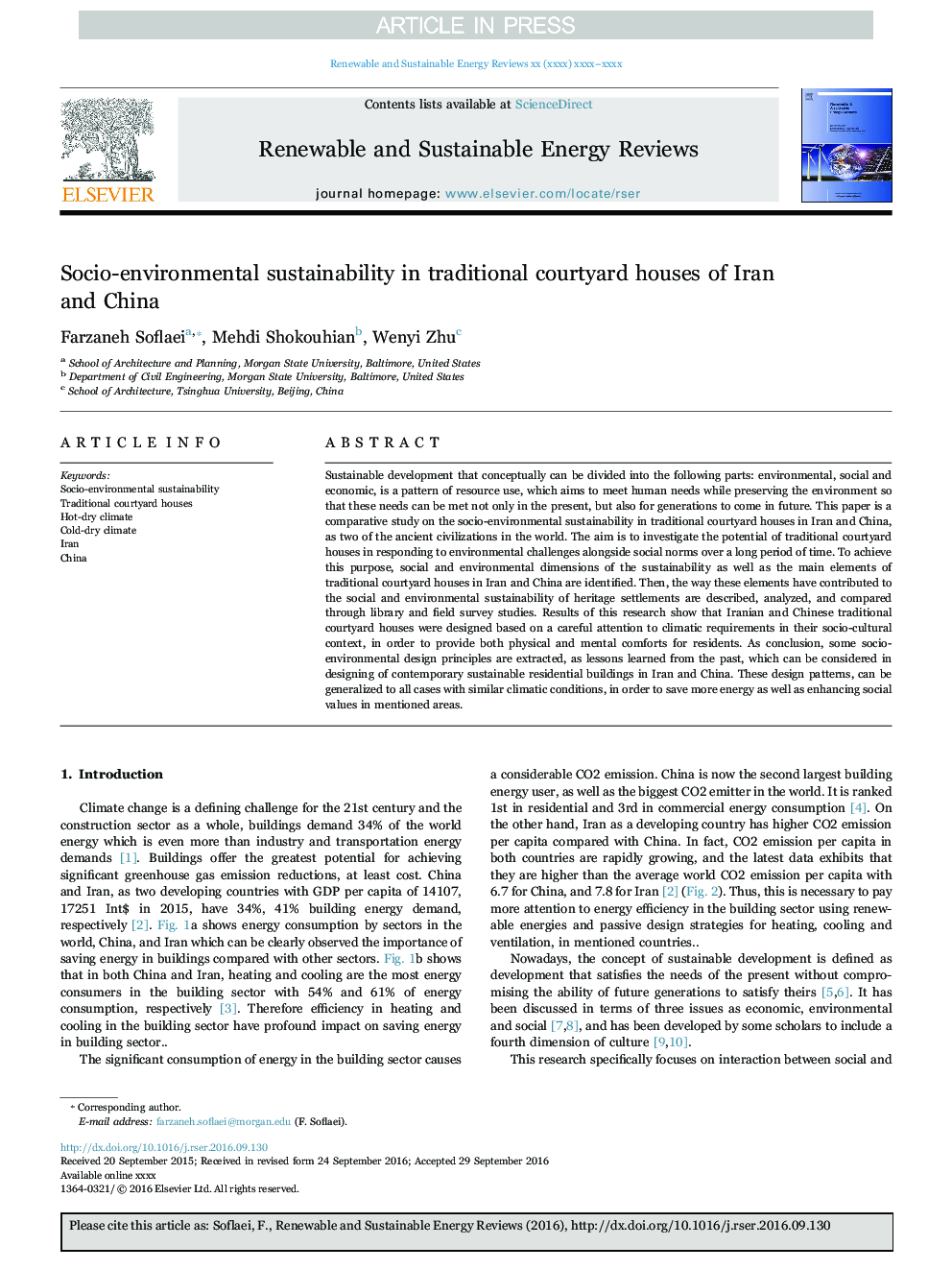| کد مقاله | کد نشریه | سال انتشار | مقاله انگلیسی | نسخه تمام متن |
|---|---|---|---|---|
| 5483397 | 1522317 | 2017 | 23 صفحه PDF | دانلود رایگان |
عنوان انگلیسی مقاله ISI
Socio-environmental sustainability in traditional courtyard houses of Iran and China
ترجمه فارسی عنوان
پایداری اجتماعی و محیطی در منازل سنتی ایران و چین
دانلود مقاله + سفارش ترجمه
دانلود مقاله ISI انگلیسی
رایگان برای ایرانیان
کلمات کلیدی
پایداری اجتماعی و محیطی، خانه های سنتی حیاط، آب و هوای گرم و خشک، آب و هوای سرد و خشک، ایران، چین،
ترجمه چکیده
توسعه پایدار که مفهومی را می توان به بخش های زیر تقسیم کرد: محیط زیست، اجتماعی و اقتصادی، یک الگوی استفاده از منابع است که هدف آن پاسخگویی به نیازهای انسانی در حین حفظ محیط زیست است تا این نیازها بتواند نه تنها در حال حاضر، بلکه همچنین برای نسل های آینده آمده است. این مقاله یک مطالعه مقایسه ای در مورد پایداری اجتماعی و محیطی در خانه های سنتی سنتی در ایران و چین به عنوان دو تمدن باستانی در جهان است. هدف این است که ظرفیت حیاط های سنتی سنتی در پاسخ دادن به چالش های زیست محیطی در کنار هنجارهای اجتماعی در طی مدت زمان طولانی بررسی شود. برای دستیابی به این هدف، ابعاد اجتماعی و زیست محیطی پایداری و همچنین عناصر اصلی حیاط های سنتی در ایران و چین شناسایی می شوند. سپس، شیوه ای که این عناصر به پایداری اجتماعی و محیطی شهرک های میراث کمک کرده اند، شرح داده شده، تحلیل شده و با استفاده از مطالعات کتابخانه ای و مطالعات میدانی مقایسه شده است. نتایج این تحقیق نشان می دهد که خانه های حیاط سنتی سنتی ایرانی و چینی براساس توجه ویژه به شرایط آب و هوایی در محدوده اجتماعی و فرهنگی آنها طراحی شده است تا از نظر فیزیکی و روحی برای ساکنین فراهم شود. به عنوان نتیجه گیری، بعضی از اصول طراحی اجتماعی-محیطی استخراج می شوند، به عنوان درس هایی که از گذشته یاد می شود، که می تواند در طراحی ساختمان های مدرن مسکونی در ایران و چین در نظر گرفته شود. این الگوهای طراحی، می تواند برای همه موارد با شرایط مشابه آب و هوایی تعمیم داده شود، به منظور صرفه جویی در انرژی بیشتر و همچنین افزایش ارزش های اجتماعی در مناطق ذکر شده.
موضوعات مرتبط
مهندسی و علوم پایه
مهندسی انرژی
انرژی های تجدید پذیر، توسعه پایدار و محیط زیست
چکیده انگلیسی
Sustainable development that conceptually can be divided into the following parts: environmental, social and economic, is a pattern of resource use, which aims to meet human needs while preserving the environment so that these needs can be met not only in the present, but also for generations to come in future. This paper is a comparative study on the socio-environmental sustainability in traditional courtyard houses in Iran and China, as two of the ancient civilizations in the world. The aim is to investigate the potential of traditional courtyard houses in responding to environmental challenges alongside social norms over a long period of time. To achieve this purpose, social and environmental dimensions of the sustainability as well as the main elements of traditional courtyard houses in Iran and China are identified. Then, the way these elements have contributed to the social and environmental sustainability of heritage settlements are described, analyzed, and compared through library and field survey studies. Results of this research show that Iranian and Chinese traditional courtyard houses were designed based on a careful attention to climatic requirements in their socio-cultural context, in order to provide both physical and mental comforts for residents. As conclusion, some socio-environmental design principles are extracted, as lessons learned from the past, which can be considered in designing of contemporary sustainable residential buildings in Iran and China. These design patterns, can be generalized to all cases with similar climatic conditions, in order to save more energy as well as enhancing social values in mentioned areas.
ناشر
Database: Elsevier - ScienceDirect (ساینس دایرکت)
Journal: Renewable and Sustainable Energy Reviews - Volume 69, March 2017, Pages 1147-1169
Journal: Renewable and Sustainable Energy Reviews - Volume 69, March 2017, Pages 1147-1169
نویسندگان
Farzaneh Soflaei, Mehdi Shokouhian, Wenyi Zhu,
